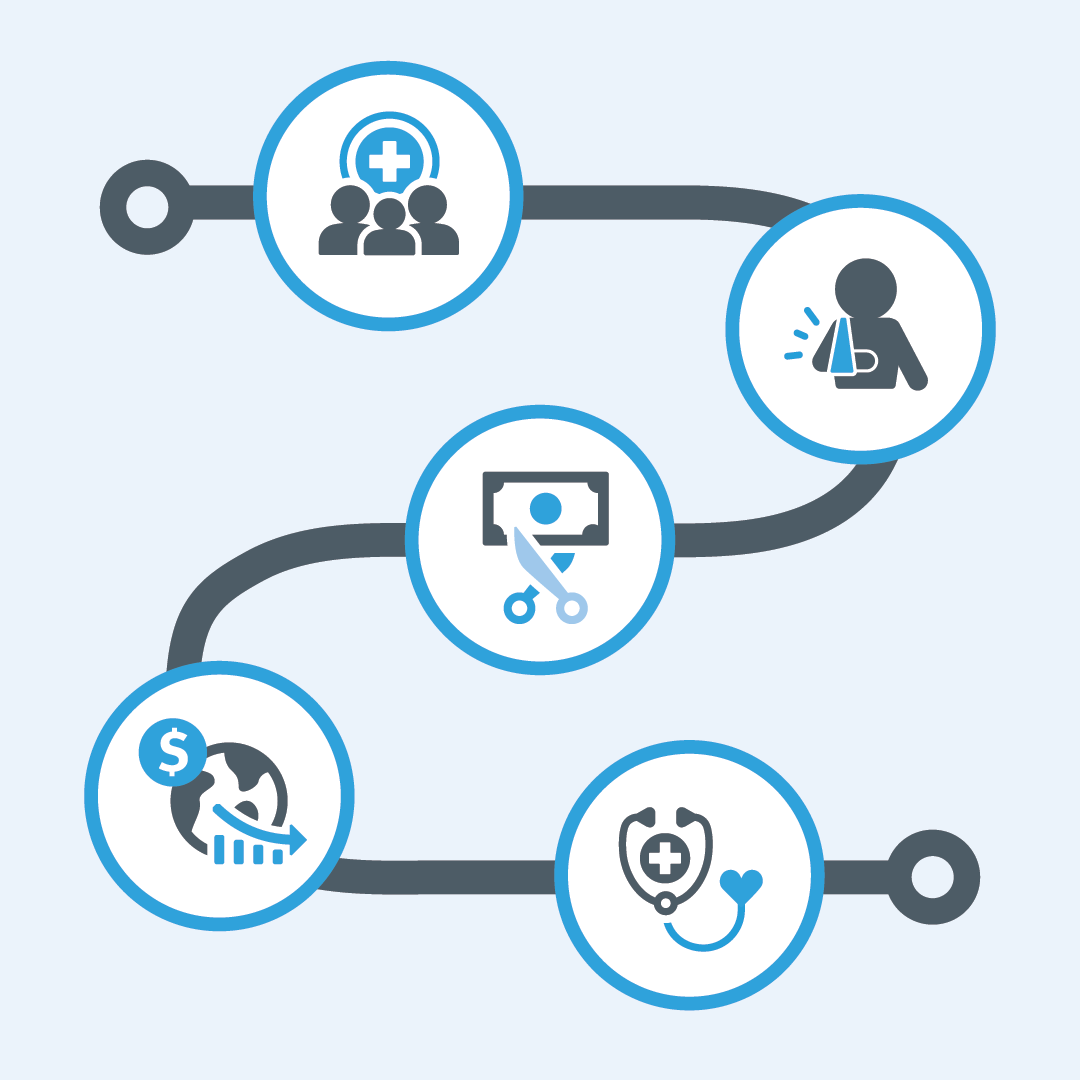
It’s Time to Reform Medicaid Eligibility and Enrollment
03.20.2024
Since the end of the federal public health emergency declaration for COVID-19 and the end of continuous eligibility for Medicaid in April 2023, states have been redetermining every enrollee’s eligibility for the program. In the last year, over 17.4 million people have been disenrolled from Medicaid — potentially losing access to needed health care services and protection from high health care costs.1 The bulk of those disenrollments are for so-called “procedural” reasons — meaning people didn’t complete the redetermination process (or reapply for Medicaid coverage) for some reason — rather than because the state had evidence they were no longer eligible.
These disenrollments often come as a surprise to people and cause significant distress, leaving individuals confused about their coverage options including how to reapply for Medicaid when they were not previously aware that they needed to. Take for instance Joe, a bus driver for his local senior center in Delaware who relies on Medicaid for his health care. In February 2024, he received a letter in the mail informing him that his coverage would be terminated effective the following week, since he had not completed the “review” or reapplication for Medicaid. Joe has not experienced a change in his employment status, housing, or income, so he was surprised to hear his coverage needed to be reviewed. Currently, Joe is in a holding pattern while he waits for a “fair hearing” to determine his eligibility.
States Are Overburdened, and People Get Lost in the Shuffle
These procedural disenrollments have pulled back the curtain on another longstanding problem in Medicaid: Churn. Churn is when people lose health coverage and then re-enroll a few months later. In 2018, 10.3% of full Medicaid beneficiaries had a gap in coverage of nearly one year.2 Churn can impede access to health care, increase state administrative costs by $400–600 per enrollee, and put patients at risk of unexpected and costly health care expenses.3
While sometimes resulting from short-term changes in income or eligibility circumstances, churn is largely the result of bureaucratic enrollment processes that are cumbersome for both states and enrollees. States are responsible for determining a person’s eligibility for Medicaid and some states’ processes involve more paperwork and administration than others. For example, according to KFF, most renewals in Texas are done through a renewal form on the website, over the phone, or through the mail.4 All of this is very labor intensive relative to using automatic processes where enrollment is confirmed from state data sources like state wage databases.
These challenges are further compounded when state Medicaid agencies have difficulties finding workers to fill key positions. With average vacancy rates of 17%, staffing shortages play a significant role in application backlogs and more people losing coverage.5,6 In 2022, one in four Medicaid agencies had vacancy rates above 20%.7
Understaffed state Medicaid offices and resulting complications mean that people are often lost in the shuffle when they try to renew their benefits. This administrative shuffle only deepens systematic inequities as existing racial and ethnic health disparities are exacerbated by inefficient enrollment processes. In Florida, the average English-speaking caller had to wait 36 minutes to speak to a state representative while the average Spanish speaker had to wait 2.5 hours.8
Though states are supposed to abide by language access requirements to ensure that individuals have access to their federally funded programs, these disparities between Spanish-and English-speaking hold times shows that these failures can interfere with a person’s ability to get care.
Reforms to Move Forward
There are better ways of doing things:
- Establish ex parte redeterminations processes in all states: Renewals that are “ex parte” are done without the beneficiary needing to submit eligibility information to the state. Instead, the state uses available data sources to check ongoing eligibility prior to asking for redetermination forms. The Affordable Care Act (ACA) and 42 U.S.C. §435.916(2) required states to use the ex parte process to assess individuals’ eligibility for Medicaid but not all states do.9 Throughout the unwinding process we’ve seen states with high ex parte rates, like North Carolina and Arizona, have fewer procedural disenrollments from Medicaid.10Importantly, when used effectively, ex parte can help states update addresses, phone numbers, and email addresses to better reach beneficiaries for all types of programs. This is particularly helpful for low-income families who move more often and can have different addresses over several years.
- Ensure one year of continuous eligibility for adults: While 12-month continuous eligibility for children went into effect in January 2024, states need to apply for a Section 1115 waiver to extend continuous eligibility to adults. New York is the only state that has done so to date. The Commonwealth Fund found that if all states had 12-month continuous eligibility for adults, 451,000 more adults would be enrolled in Medicaid in an average month, a 1.3% increase. Federal and state spending would increase less than 0.1% ($479 million and $158 million respectively) but households and employers would save roughly $1 billion and total health care spending would decline by $1.8 billion in 2024.
- Extend the 1902(e)(14) waivers: The Centers for Medicare and Medicaid Services (CMS) established several new enrollment flexibilities under Section §1902(e)(14) for states to use while going through the unprecedented post-pandemic redetermination process.11 These included flexibilities like making it easier to conduct ex parte renewals and allowing Medicaid Managed Care plans to help enrollees re-enroll. Rather than requiring states to apply for individual waivers and State Plan Amendments (SPAs) to continue to use these flexibilities, the agency should codify them into existing regulations.For example, the temporary (e)(14) waivers allow states to use supplemental nutrition assistance program (SNAP) data to confirm Medicaid eligibility. Normally, states must obtain a waiver to use SNAP to determine Medicaid eligibility even though federal regulation directs states to use available data sources to confirm eligibility. CMS should make this process more streamlined as the agency has limited bandwidth to review waivers and states have limited bandwidth to apply for them. A Medicaid and CHIP Payment and Access Commission (MACPAC) report found that states reported operationalizing SPAs is more complex than implementing a §1902(e)(14)(a) waiver.12
While there are many lessons to be learned from COVID-19-era policies and processes, streamlining Medicaid enrollment to make it easier for people to get and maintain the health coverage they are eligible for is an obvious place to start.
Footnotes:
1. https://www.kff.org/report-section/medicaid-enrollment-and-unwinding-tracker-overview/
2. https://www.kff.org/medicaid/issue-brief/medicaid-enrollment-churn-and-implications-for-continuous-coverage-policies/
3. https://www.americanprogress.org/article/how-states-can-build-bridges-by-smoothing-medicaid-to-marketplace-coverage-transitions/#:~:text=A%202015%20Health%20Affairs%20analysis,in%20a%2012%2Dmonth%20period.
4. https://www.kff.org/medicaid/issue-brief/medicaid-enrollment-and-unwinding-tracker/
5. https://medicaiddirectors.org/resource/situating-medicaid-agencies-future-work-in-todays-realities/
6. https://everytexan.org/tracking-texas-medicaid-snap-delays/
7. https://medicaiddirectors.org/resource/situating-medicaid-agencies-future-work-in-todays-realities/
8. https://unidosus.org/publications/long-and-discriminatory-delays-at-floridas-call-center/
9. https://www.govinfo.gov/content/pkg/CFR-2015-title42-vol4/pdf/CFR-2015-title42-vol4-sec435-916.pdf
10. https://www.kff.org/medicaid/issue-brief/medicaid-enrollment-and-unwinding-tracker/
11. https://www.medicaid.gov/resources-for-states/coronavirus-disease-2019-covid-19/unwinding-and-returning-regular-operations-after-covid-19/covid-19-phe-unwinding-section-1902e14a-waiver-approvals/index.html<
12. https://www.macpac.gov/wp-content/uploads/2023/09/Increasing-the-Rate-of-Ex-Parte-Renewals-Brief.pdf




